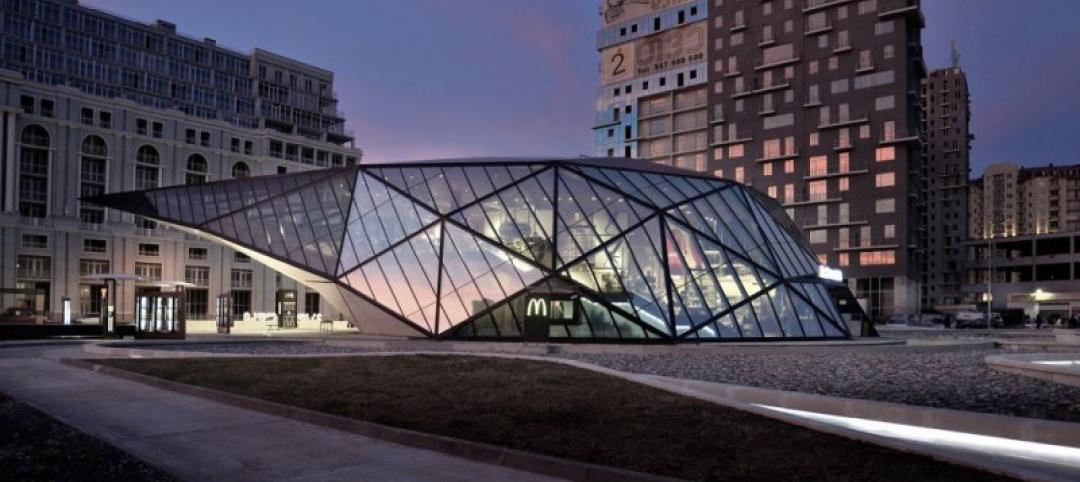Designed by Pietro Belluschi, the Juilliard School in New York’s Lincoln Center for the Performing Arts had remained relatively untouched since its completion in 1969. In the early 2000s, a plan was conceived to make Lincoln Center—and Juilliard—more architecturally engaged with the general public and its Upper West Side neighbors.
In an effort to offer additional educational opportunities to the growing number of students, officials at the school sought to add 39,000 sf of classrooms, practice rooms, and rehearsal spaces, as well as two new performance venues. The design also called for more informal social spaces for students and greater access to daylight, as well as an upgrade of the public entrance to integrate the building—a classic example of the Brutalist movement—more fully into the landscape of the Lincoln Center campus.
Renovating on the Upper West Side
Working with a Building Team that included a design collaboration between New York-based firms FXFOWLE Architects and Diller Scofidio + Renfro, engineering firms Arup and Langan Engineering & Environment Services, and Turner Construction Co., the administration sought to preserve the iconic elements of Belluschi’s design while meeting the needs of students and creating a more public identity for the building.
Numerous stakeholders had to be consulted—this is, after all, New York—from academic department heads to Lincoln Center’s 14 other constituent organizations, as well as the New York City Department of Planning, neighborhood and community boards, and the New York State Historic Preservation Office.
Moreover, the Building Team was to undertake the project while Juilliard remained fully occupied and functional. With an institution whose very soul relied on quality acoustics for its existence, mitigating sound during construction was a primal concern for the Building Team. “The challenge in renovating the antiquated, Brutalist space was to perform surgery on part of the building while still allowing full bodily function of the other organs,” says Heidi Blau, AIA, LEED AP, a partner at FXFOWLE.
PROJECT SUMMARY
The Juilliard School Renovation and Expansion, New York City, N.Y.
Building Team
Owner/developer: The Juilliard School
Architects: FXFOWLE Architects (submitting firm) and Diller Scofidio + Renfro
Structural engineer: Arup
Civil engineer: Langan Engineering & Environment Services
GC/CM: Turner Construction Co.General Information
Size: 39,000 sf
Construction cost: Confidential at owner’s request
Construction period: 2005 to 2010
Delivery method: CM
To meet these demands, a sophisticated plan of phasing, relocation, use of temporary facilities, and incremental reoccupation was developed. Blau says she envisioned the process as one “where one facet might undergo a transformation without disrupting the integrity of the project as a whole.” The use of swing space was an important strategy. For example, an infill interior courtyard was made into a temporary classroom; later, the space was converted to a permanent orchestra rehearsal room.
Opening up to the community
For more than four decades, the Juilliard building presented a fortress-like appearance to the surrounding community, a manifestation of the Brutalist design that Blau says “reflected a cloistered approach to the arts.” The Lincoln Center campus master plan called for a more open and inviting Juilliard.
The first step was to open up Juilliard’s entryway into a three-story lobby, thereby extending a warm welcome to visitors entering from 65th Street. The glass lobby connects spaces at street level, where many public programs are offered, to the student lounge on the second level and administration offices on the third. LED information boards, computer terminals, and a coffee bar invite more opportunities for students to meet and socialize; a glass box office is easily accessible to visitors and patrons. The lobby’s new grand staircase contains specially cut sections that provide communal spaces for those in transit from one floor to another, a feature that the BD+C Reconstruction Awards jury, notably juror Martha Bell, FAIA, found “very interesting.”
The façade, with its three-story glass curtain walls along Broadway, entices neighbors and passersby to look in, while at the same time projecting the school’s energy out into the community. The glass wall brings much more natural daylight into the school’s once dark, labyrinthine interiors.
Staying true to form
All this, while still retaining Belluschi’s stone details elsewhere on the exterior elevations. “The building façade includes more than 10 different types of glass in order to meet the distinct technical requirements of strength, acoustics, and thermal performance of the exterior wall,” says Peter Pesce, AIA, a senior associate at FXFOWLE. “Matching the original stone details while employing modern construction techniques proved challenging.”
Respecting the original Brutalist design was important to the Building Team. Travertine cladding was used from the very quarry where the original was mined, providing continuity of materials. Says Blau, “The careful surgery performed on Pietro Belluschi’s building was predicated on the existence of robust bones—able to support the transformation while retaining a significant portion of the existing travertine and concrete.”
Taking on the renovation of one of New York City’s cultural treasures required not only an appreciation for the original design, but also a sensitivity to the legitimate concerns of numerous stakeholders. The renovation and expansion of the Juilliard School has transformed the revered institution into a more modern performing arts center while preserving its architectural heritage. It is for these reasons that our Reconstruction Awards jury has designated this project as a Bronze winner. +
Related Stories
| Feb 5, 2014
M&A activity down in 2013 among architecture, engineering firms: Report
In 2013, consultant Morrissey Goodale observed 168 sales of U.S.-based architecture and engineering (“A/E”) firms – down nearly 7% from the record 180 sales of U.S.-based A/E firms in 2012.
| Feb 5, 2014
BIA Opens Entries for 25th Annual Brick in Architecture Awards
Entries open on February 10 for the Brick Industry Association's (BIA) Brick in Architecture Awards. Celebrating its silver anniversary, BIA's annual honors spotlight outstanding, innovative and sustainable architecture that incorporates clay brick products as the predominant exterior building or paving material.
| Feb 5, 2014
Multifamily Housing, Green Building, Market Trends, Innovation to be Prime Topics at MBI’s World of Modular
More than 600 developers, contractors, architects, builders, dealers and equipment/service suppliers are expected at the event, slated for March 21-24 in San Antonio, Texas, and hosted by the Modular Building Institute.
| Feb 5, 2014
7 towers that define the 'skinny skyscraper' boom [slideshow]
Recent advancements in structural design, combined with the loosening of density and zoning requirements, has opened the door for the so-called "superslim skyscraper."
| Feb 4, 2014
World's fifth 'living building' certified at Smith College [slideshow]
The Bechtel Environmental Classroom utilizes solar power, composting toilets, and an energy recovery system, among other sustainable strategies, to meet the rigorous performance requirements of the Living Building Challenge.
| Feb 4, 2014
Must see: Student housing complex made with recycled shipping containers
Architect Christian Salvati's new structure is just the first step in bringing shipping container construction to New Haven, Conn.
| Feb 3, 2014
Gehry wins bid to design Berlin's tallest tower [slideshow]
The architect's "rotating cubes" scheme for the 300-unit residential tower beat out design submissions by eight other prominent firms, including Adjaye Associates and David Chipperfield Architects.
| Jan 31, 2014
Trump Hotel Collections announces luxury hotel for Rio de Janeiro
The 13-story, 171-guestroom Trump Rio will be Trump Hotel Collection’s first property in South America and the only luxury hotel in the neighborhood when it opens in 2016.
| Jan 31, 2014
LEGO, Google partner to develop 3D modeling tool for LEGO structures
The free tool, called Build, allows Chrome users to create virtual 3D structures using any shape and color in the LEGO catalog.
| Jan 31, 2014
Ultra-modern McDonald's restaurant voted one of world's best new buildings
This McDonald's, which is combined with a fuel station and recreation areas, was awarded the Best Commercial Building of the Year by architecture website ArchDaily.














